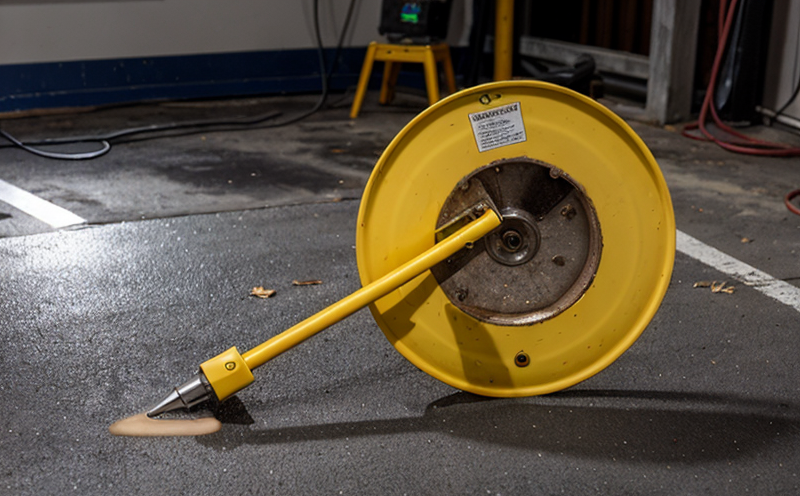ASTM E2580 Infrared Thermography for NDT of AM Parts
The ASTM E2580 standard specifies the use of infrared thermography (IR) as a non-destructive testing (NDT) method for identifying defects in parts produced using additive manufacturing (AM). This technique is particularly valuable because it allows for rapid and accurate assessment without compromising the integrity of the part. The method relies on the principle that thermal anomalies can indicate areas of concern within the AM process, such as porosity, cracks, or other internal flaws.
The testing process involves heating the part uniformly to a predetermined temperature range using controlled heat sources like lasers or resistance heaters. Once heated, the part is allowed to cool down naturally under ambient conditions while an infrared camera captures thermal images at various intervals. The software then processes these images to identify any anomalies that could indicate defects. This method is non-invasive and can be applied post-process for quality assurance.
The ASTM E2580 standard provides detailed guidelines on specimen preparation, including the type of heat source used, cooling conditions, and the exact temperature range over which the thermographic images should be captured. It also specifies the acceptable tolerances within which defects can or cannot be identified. This ensures that the testing process is consistent across different facilities, thereby enhancing reliability.
One significant advantage of using ASTM E2580 IR for NDT in AM parts is its ability to detect internal flaws that are not visible through visual inspection alone. For instance, it has been successfully used in detecting porosity and cracks within metal parts fabricated by laser powder bed fusion (LPBF) processes. The method's high sensitivity makes it particularly useful for quality control in industries like aerospace, automotive, and medical device manufacturing.
Another benefit is the speed at which this testing can be performed compared to other NDT methods. For large-scale production environments, ASTM E2580 IR can provide real-time data that helps in identifying defects early in the process, thus reducing rework costs. Additionally, it can help ensure compliance with stringent quality standards set by regulatory bodies.
Despite its advantages, there are certain limitations to consider when employing ASTM E2580 IR for AM parts testing. Factors such as surface finish and material thickness can affect the accuracy of the results. Therefore, proper calibration and operator training are crucial for obtaining reliable data.
| Industry Applications | Description |
|---|---|
| Aerospace | Identifying internal defects in critical components like turbine blades and engine casings. |
| Automotive | Ensuring structural integrity of parts used in high-performance vehicles. |
| Medical Device Manufacturing | Evaluating the quality of implants and prosthetics made from precision AM techniques. |
| Defense and Security | Detecting flaws in components used in defense equipment for enhanced safety. |
In summary, ASTM E2580 infrared thermography offers a robust solution for non-destructive evaluation of AM parts. Its ability to detect internal defects accurately and efficiently makes it an indispensable tool in ensuring the quality of additive manufacturing processes across various industries.
Industry Applications
- Aerospace: Identifying internal defects in critical components like turbine blades and engine casings.
- Automotive: Ensuring structural integrity of parts used in high-performance vehicles.
- Medical Device Manufacturing: Evaluating the quality of implants and prosthetics made from precision AM techniques.
- Defense and Security: Detecting flaws in components used in defense equipment for enhanced safety.
The ASTM E2580 standard is widely recognized and adopted by these industries, making it a cornerstone for ensuring the quality of AM parts. By adhering to this standard, manufacturers can ensure that their products meet rigorous international standards and specifications.
Why Choose This Test
- Non-Destructive: ASTM E2580 IR allows for the evaluation of parts without causing any damage.
- Rapid Assessment: It provides quick results, ideal for high-throughput production environments.
- High Sensitivity: The method can detect even subtle internal defects that are not visible through visual inspection alone.
- Consistent Results: Standardized procedures ensure consistent and reliable testing across different facilities.
- Comprehensive Coverage: It evaluates parts from multiple angles, providing a comprehensive view of the component's integrity.
- Educational Value: The test results can be used for training purposes to educate operators on defect identification and prevention techniques.
These advantages make ASTM E2580 IR an essential tool in ensuring the quality and reliability of AM parts across various industries. By choosing this test, organizations can enhance their production processes and maintain a high standard of product quality.
International Acceptance and Recognition
The ASTM E2580 standard for infrared thermography in NDT of AM parts has gained widespread acceptance and recognition globally. This is due to its stringent requirements and consistent results across different testing facilities. The International Organization for Standardization (ISO) and other global bodies have recognized the importance of this standard, leading to its adoption by numerous countries.
Many manufacturers and suppliers in sectors like aerospace, automotive, medical device manufacturing, and defense are required to comply with ASTM E2580 standards as part of their quality management systems. This compliance ensures that products meet stringent international quality requirements and specifications.
The standard's global recognition also facilitates international trade by ensuring a common benchmark for AM parts testing. This consistency helps in building trust between suppliers and customers, fostering a collaborative environment for innovation and growth.





